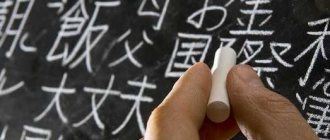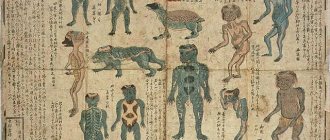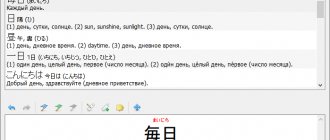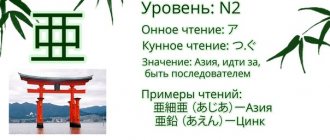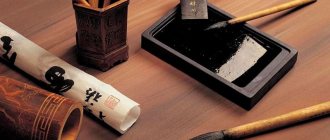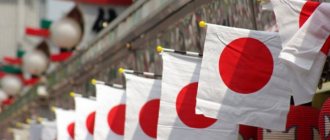Let's learn Japanese from scratch! レッスン3 – Lesson 3
Japanese alphabet and its transcription using Latin characters
The need to study Romaji is dictated primarily by the fact that this alphabet is used both in Japan and in Russia and foreign countries. In addition, knowledge of romaji makes it possible to correctly convey in practical Russian transcription Japanese names, first names and surnames found in languages using the Latin script.
Since the appearance of the first Romaji texts recorded by missionaries, various systems for writing Japanese text in Latin letters have been put forward, but currently the most common of them are two: the state Japanese Latin script, intended for the Japanese, and the so-called Hepburn Latin script, created at one time for English speakers.
Everything here is the same as in the previous lessons, only in letters of the Latin alphabet. They need to be remembered. The rest is optional (more details later).
Japanese alphabet in Latin transcription (Hepburn Latin)
| A | K.A. | S.A. | T.A. | N.A. | H.A. | M.A. | YA | R.A. | W.A. | |
| I | KI | SHI | CHI | NI | HI | MI | R.I. | |||
| U | KU | S.U. | TSU | NU | F.U. | M.U. | YU | RU | ||
| E | KE | S.E. | T.E. | NE | HE | M.E. | RE | |||
| O | K.O. | SO | TO | NO | HO | M.O. | YO | R.O. | (W)O | N |
Column syllables KA, SA, TA, HA and their voiced correspondence in Latin transcription (Hepburn Latin)
| K.A. | GA | S.A. | ZA | T.A. | D.A. | H.A. | B.A. | PA |
| KI | G.I. | SHI | JI | CHI | JI | HI | B.I. | P.I. |
| KU | G.U. | S.U. | ZU | TSU | ZU | F.U. | B.U. | P.U. |
| KE | G.E. | S.E. | ZE | T.E. | DE | HE | BE | P.E. |
| K.O. | GO | SO | ZO | TO | DO | HO | B.O. | P.O. |
Syllables with soft consonants in Latin transcription (Hepburn Latin)
| KI KYA SHI SHA CHI CHA NI NYA | GI GYA JI JA JI JA — | HI HYA MI MYA RI RYA | BI BYA — — | PI PYA |
| KI KYU SHI SHU CHI CHU NI NYU | GI GYU JI JU JI JU — | HI HYU MI MYU RI RYU | BI BYU — — | PI PYU |
| KI KYO SHI SHO CHI CHO NI NYO | GI GYO JI JO JI JO — | HI HYO MI MYO RI RYO | BI BYO — — | PI PYO |
Differences between the state (1) and Hepburn (2) Latin alphabet systems
| 1 | S.A. | S.I. | S.U. | S.E. | SO | S.Y.A. | SYU | S.Y.O. |
| 2 | S.A. | SHI | S.U. | S.E. | SO | SHA | SHU | SHO |
| 1 | T.A. | T.I. | T.U. | T.E. | TO | T.Y.A. | TYU | TYO |
| 2 | T.A. | CHI | TSU | T.E. | TO | CHA | CHU | CHO |
| 1 | ZA | ZI | ZU | ZE | ZO | ZYA | ZYU | ZYO |
| 2 | ZA | JI | ZU | ZE | ZO | JA | J.U. | JO |
| 1 | D.A. | ZI | ZU | DE | DO | ZYA | ZYU | ZYO |
| 2 | D.A. | JI | ZU | DE | DO | JA | J.U. | JO |
| 1 | H.A. | HI | HU | HE | HO | HYA | HYU | HYO |
| 2 | H.A. | HI | F.U. | HE | HO | HYA | HYU | HYO |
Definitions
Romaji
is a writing system in the Japanese language based on the Latin alphabet.
Kiriji
or
Rossiyaji
is a system of recording (
transcription
) of Japanese words based on the Cyrillic alphabet.
Used by Japaneseists and otaku in Russia. The original version of kiriji was proposed in 1917 by the outstanding Russian orientalist E. D. Polivanov
, which is why it is often called the “Polivanov system.”
Hiragana
and
Katakana
are syllabic alphabets (each character means a syllable, not a sound) used in the Japanese language. Each of them includes 46 characters (and a few obsolete ones). See also the article on hiragana and the article on katakana.
Kanji
— hieroglyphics (each symbol denotes a concept). There are currently about 5,000 kanji in use in Japan, 1,942 of which are included in the government's recommended list for everyday use. The rest are practically found only in ancient names and ancient surnames. The Japanese borrowed the vast majority of kanji from China, but they composed some themselves. Calligraphy, the “fine” drawing of kanji, is an important part of Japanese school art education.
If the following text seems too complicated or boring to you, you can use our “Automatic Converter” to convert kiriji to romaji and back. However, it is not perfect, so it is better to still read what is written below. ^_^
Summary table of characters of the Katakana and Hiragana alphabets (with Russian transcription and Romaji)
| ア | カ | サ | タ | ナ | ハ | マ | ヤ | ラ | ワ | |
| あ | か | さ | た | な | は | ま | や | ら | わ | |
| A | CA | SA | TA | ON | HA | MA | I | RA | VA | |
| A | K.A. | S.A. | T.A. | N.A. | H.A. | M.A. | YA | R.A. | W.A. | |
| イ | キ | シ | チ | ニ | ヒ | ミ | リ | |||
| い | き | し | ち | に | ひ | み | り | |||
| AND | CI | SI | TI | NI | CI | MI | RI | |||
| I | KI | SHI | CHI | NI | HI | MI | R.I. | |||
| ウ | ク | ス | ツ | ヌ | フ | ム | ユ | ル | ||
| う | く | す | つ | ぬ | ふ | む | ゆ | る | ||
| U | KU | SU | CC | WELL | UGH | MU | YU | RU | ||
| U | KU | S.U. | TSU | NU | F.U. | M.U. | YU | RU | ||
| エ | ケ | セ | テ | ネ | ヘ | メ | レ | |||
| え | け | せ | て | ね | へ | め | れ | |||
| E | CE | SE | TE | NE | HE | ME | RE | |||
| E | KE | S.E. | T.E. | NE | HE | M.E. | RE | |||
| オ | コ | ソ | ト | ノ | ホ | モ | ヨ | ロ | ヲ | ン |
| お | こ | そ | と | の | ほ | も | よ | ろ | を | ん |
| ABOUT | KO | CO | THAT | BUT | XO | MO | Yo | RO | ABOUT | N |
| O | K.O. | SO | TO | NO | HO | M.O. | YO | R.O. | (W)O | N |
| ガ | ザ | ダ | バ | パ | ||
| が | ざ | だ | ば | ぱ | ||
| GA | DZA | YES | BA | PA | ||
| GA | ZA | D.A. | B.A. | PA | ||
| ギ | ジ | ヂ | ビ | ピ | ||
| ぎ | じ | ぢ | び | ぴ | ||
| GI | DZI | DZI | BI | PI | ||
| G.I. | JI | JI | B.I. | P.I. | ||
| グ | ズ | ヅ | ブ | プ | ||
| ぐ | ず | づ | ぶ | ぷ | ||
| GU | DZU | DZU | BOO | PU | ||
| G.U. | ZU | ZU | B.U. | P.U. | ||
| ゲ | ゼ | デ | ベ | ペ | ||
| げ | ぜ | で | べ | ぺ | ||
| GE | DZE | DE | BE | PE | ||
| G.E. | ZE | DE | BE | P.E. | ||
| ゴ | ゾ | ド | ボ | ポ | ||
| ご | ぞ | ど | ぼ | ぽ | ||
| GO | SDC | BEFORE | BO | BY | ||
| GO | ZO | DO | B.O. | P.O. | ||
| キャ | シャ | チャ | ニャ | ヒャ | ミャ | リャ |
| きゃ | しゃ | ちゃ | にゃ | ひゃ | みゃ | りゃ |
| KY | SY | TY | AE | HY | MY | RY |
| KYA | SHA | CHA | NYA | HYA | MYA | RYA |
| ギャ | ジャ | ヂャ | ビャ | ピャ | ||
| ぎゃ | じゃ | ぢゃ | びゃ | ぴゃ | ||
| GY | DZYA | DZYA | BY | PY | ||
| G.Y.A. | JA | JA | BYA | P.Y.A. | ||
| キュ | シュ | チュ | ニュ | ヒュ | ミュ | リュ |
| きゅ | しゅ | ちゅ | にゅ | ひゅ | みゅ | りゅ |
| KY | SJ | TY | Nude | HY | Manchester United | RU |
| KYU | SHU | CHU | NYU | HYU | MYU | RYU |
| ギュ | ジュ | ヂュ | ビュ | ピュ | ||
| ぎゅ | じゅ | ぢゅ | びゅ | ぴゅ | ||
| GY | JJU | JJU | BYU | PY | ||
| GYU | J.U. | J.U. | BYU | PYU | ||
| キョ | ショ | チョ | ニョ | ヒョ | ミョ | リョ |
| きょ | しょ | ちょ | にょ | ひょ | みょ | りょ |
| KYO | SIO | THOSE | NOT | HYO | MIO | RYO |
| KYO | SHO | CHO | NYO | HYO | MYO | RYO |
| ギョ | ジョ | ヂョ | ビョ | ピョ | ||
| ぎょ | じょ | ぢょ | びょ | ぴょ | ||
| GYO | JO | JO | BYO | PYO | ||
| G.Y.O. | JO | JO | BYO | PYO | ||
Notes:
1. In Japanese there are long and short vowel sounds. The length of the vowel plays a meaningful role. So, KADO means “gate”, and KA:DO means “card”. In the case of transcription using the letters of the Russian alphabet, the length of vowels is indicated by doubling the corresponding vowel (KAA), a short line above the vowel sound (KA̅) or a colon (KA:); in the case of transcription in Latin letters, the length of vowels is indicated similarly (FUU, FU:); when written in katakana alphabet, vowel length is indicated by doubling the vowel or by a horizontal line in the middle of the line (サア SA:, サー SA:); When a hiragan’s alphabet is recorded, the longitude of the vowels can be indicated by doubling the corresponding vowel (お う o: こう こう こう すう すう SU :) or (in the case of vowels お, ゆ, よ) vowel う (お う こう こう, び よう, り, り, り, り,ゆう RYU:). A double vowel sound in some cases can indicate not only a long vowel, but also the presence of a syllable. For example すう (SU-U “to pass”).
2. The vowel sound U in the position between voiceless consonants, between a voiceless consonant and C, in the final syllable SU is sometimes reduced to the point of complete disappearance. So, SUKOSI is pronounced [skosi], DESU is pronounced [des], UTSUKUSIY is pronounced [utsksi:]; The vowel sound I is reduced in the position between voiceless consonants, between a voiceless consonant and C. For example, ASITA is pronounced [asta], SITSUMON is pronounced [ssumon].
The reduction of vowels い and う is indicated by a short horizontal line above the vowel sound (Ī, Ū) or in Russian transcription И, Ў. The vowel い in a position after another vowel is in many cases pronounced [y], and is designated as Y in Russian transcription.
3. In a number of Japanese words there are double consonants. To convey them, the subscript TsU is used, which is not readable, but doubles the consonant sound that follows it. For example, 才デッサ (ODESSA), はっぴょう (HAPPYO:).
4. The consonant N in the position before M, B, P is read as [m]. In this regard, a word, for example ランパ, in Russian transcription will be written: RAMPA.
5. When writing in the katakana alphabet, in addition to TsU, any sign from the following can be used as a subscript: A, I, E, O. In this case, the syllable followed by a subscript loses its vowel sound, which is replaced by a subscript. For example: ツァ CA, ティ TI, フェ FE, フォ FO. Similar cases can often be observed when writing words borrowed into Japanese from other languages.
6. In the case when, in a word, syllables consisting of the vowels A, I, U, E, O, Ya, Yu, E come after the syllable represented by the consonant N, in Russian transcription it is customary to use the dividing solid sign Ъ to show , that there are, for example, the syllables N and I, and not the syllable NI. Without taking this into account, you will not find the corresponding word, for example, in the “Big Japanese-Russian Dictionary”, ed. N.I. Conrad. Thus, the word SINAI-NARU with the meaning “beloved, dear” in this dictionary should be looked for in the form SINAI-NARU after the word SHINTSU:RIKI, and not after the word SINAI. When transcribing in Latin letters, an apostrophe is sometimes used in such cases.
7. As part of the Japanese sentence, there are so-called “case indicators”. Some of them are designated in a special way: BA (は), E (へ). The signs を and ヲ are used only to denote the case indicator O. To denote the syllable O within a word, the signs お and オ are used.
8. Regarding the stress in words, we note that the force stress that occurs in the Russian language is uncharacteristic of the Japanese language. In this regard, without going into details ( at this stage , in more detail in the following lessons), it is recommended to pronounce words with equal stress on all syllables.
9. Auxiliary signs: “゛” “ nigori ”, indicates the voicing of the corresponding consonant sound. For example が(ガ) GA. "゜" " hannigori ", indicates the semi-voicing of the corresponding consonant sound. For example ぴ(ピ) PI. “ゝ” is a repeat character of the alphabet character. For example, まゝ is equivalent to まま, and 力ゝ is equivalent to 力力. “ゞ” is a repetition sign of an alphabet character with voicing. For example, かゞ is equivalent to かが.
10. Along with the usual period and comma (. ,), Japanese texts may contain their Japanese analogues (。、).
11. To move to the next line, a Japanese word can be interrupted at any place (i.e. on any syllable). The carry sign is not placed in this case. Even the period at the end of a sentence can be moved to the next line.
How to correctly pronounce borrowings from Japanese in Russian
So, first of all, you need to keep in mind that the Latin notation of Japanese words is not English. This is one of the options for transcribing the sounds of Japanese speech, in this case in letters of the Latin alphabet, and in accordance with it there is a transcription in characters of the Russian alphabet. In it, the syllables SHA, SHI, SHU, SHO, SNA, CHI, CHU, SNO correspond to the syllables SYA, SI (and not SHI!), SYU, SIO, TYA, TI (and not CHI!), TYU, TE (and not WHAT!). The syllables JA, JI, JU, JO correspond to the syllables DZYA, DZI, DZYU, DZO. The syllable YO corresponds to E (not YO!), the vowel sound E (Latin) corresponds to E. And there shouldn’t be anything else in the Russian language. But it already is. The word “GEISHA” (not “GEISHA”!) has already entered the Russian language, and words such as “TOYOTA”, “TOSHIBA”, “HITACHI”, “SUSHI”, etc. have become entrenched in everyday communication.
The problem is that in Russian the combination [sh] is perceived as [Ш], the combination [ch] as [CH], and the voiced j as [ДЗ]. Accordingly, with an eye to the English language, [sha] [shu] [sho] is pronounced as [Sha], [SHU], [SHO]; [cha] [chu] [cho] pronounced as [CHA], [CHU], [CHO]; a [ja] [ji] [ju] [jo] is pronounced as [JA], [JI], [JU], [JO]. As a result, Japanese words written in Latin letters, proper names in particular, undergo incredible changes in Russian speech, to the point of being unrecognizable. This is how the Japanese names “Toshiba”, “Hitachi” appear in Russian, and this is how “sushi” appeared. Such pronunciation is sometimes overlaid with arbitrary stress, which in the Japanese language is very specific, in any case having little in common with the force stress in the Russian language. As a result, the name sounds like [TASHYBA] with stress on the second syllable (unstressed O in the Russian tradition is pronounced as [A]), which is unlikely to be adequately perceived by the Japanese interlocutor.
You could say this. If the legislators regarding the norms of linguistic communication were, in terms of the problems under consideration, orientalists (Japanese studies), then we would definitely say “SUSI”, “HITACHI”, “TOSIBA”, “MITSUBISHI”, “TOYOTA”, and this spelling variant would have unconditional grounds in the form of established transcription rules. But language develops according to its own laws. And our people, the native speaker and creator of the Russian language, find SUSHI closer and dearer.
The problem is not insignificant. The fact is that until recently, for many years, Japan experienced an active invasion of the Japanese language by foreign vocabulary. Now the situation is reversed. Following the spread of Japanese technology and Japanese goods throughout many countries of the world, Japaneseisms are beginning to actively penetrate into the languages of the corresponding countries (and Russia is no exception). Uniformity in the “assimilation” of Japaneseisms would be very appropriate, but, unfortunately, there is none. Although, probably, at one time in Japan, traditions of phonetic transformation of foreign language vocabulary were not immediately formed.
Since we have begun to discuss how to correctly write Japanese words in Russian, it is appropriate to say a few words about the declension of Japanese proper names. Here it is advisable to be guided by the following rule. Since the Japanese language does not know declension, it would be more correct not to change Japanese proper names, but where it is necessary to express the relationship between words in a sentence using endings, to resort to the declension of the auxiliary word, for example: “Nagoya City Municipality” (but not “Nagoya Municipality” ).
And one last thing. According to established tradition, it is customary not to indicate the length of vowels when writing proper names.
Examples of words in different systems[edit]
The kiriji notation of words is also provided here for reference.
| Word | Kanji | Cana | Romaji | Kiriji | ||
| Rev. Hepburn | Kunrei-shiki | Nihon-shiki | ||||
| letters | ローマ字 | ローマじ | rōmaji | romazi | rōmazi | ro:maji |
| Mount Fuji | 富士山 | ふじさん | Fujisan | Huzisan | Huzisan | Fujisan |
| tea | お茶 | おちゃ | ocha | otya | otya | otya |
| prefectural governor | 知事 | ちじ | chiji | tizi | tizi | chiji |
| compress, reduce | 縮む | ちぢむ | chijimu | tizimu | tidimu | chijimu |
